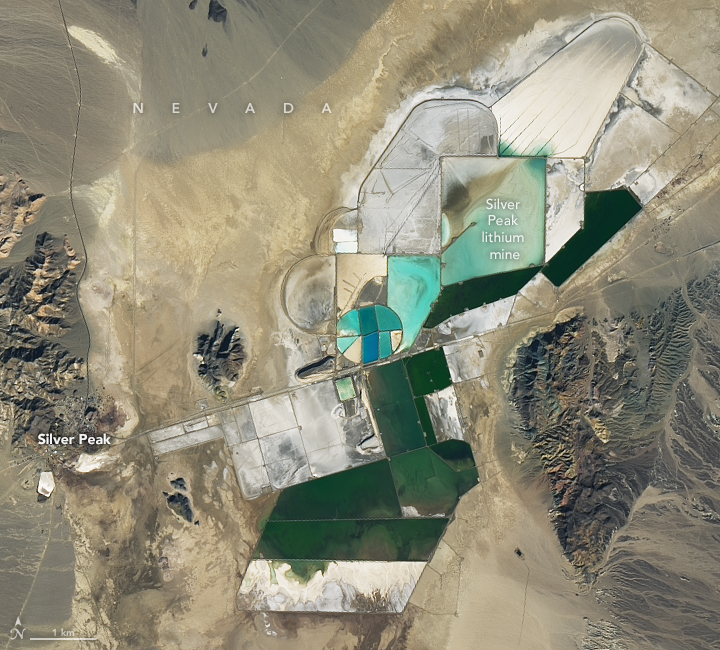
Racing to Mine Lithium
Downloads
- silverpeak_oli2_2022342_lrg.jpg (2817x1824, JPEG)
Metadata
- Sensor(s):
- Landsat 9 - OLI-2
- Data Date: December 8, 2022
- Visualization Date: December 15, 2022
Exploding white dwarf stars are thought to be the ultimate source of much of our solar system’s lithium. But on Earth, there are certain environments where the soft, light, silvery-white metal is most concentrated and easily mined—notably in briny groundwater aquifers found beneath desert salt flats.
An ideal climate for mining lithium is generally arid, punctuated by seasonal rains or melting. This allows water to pool in shallow, salty lakes and then evaporate during the summer—a cycle that helps concentrate the lithium. Thermal hot springs, volcanic activity, and a subsiding landscape also typically accompany major lithium reserves.
These conditions abound in the Atacama Desert in South America, where some of the world’s most largest lithium deposits and mining operations are located. But they can also be found in Nevada’s Clayton Valley—the site of the only active lithium mine in the United States. The town of Silver Peak was established in the 1860s around gold and silver mines, but since the 1960s the town has focused on harvesting lithium, which is concentrated under the Clayton Valley in an area where an extinct volcano left lithium-rich deposits.
The Operational Land Imager-2 (OLI-2) on Landsat 9 acquired this natural-color image of the lithium mining operation in Silver Peak on December 8, 2022. The mine pumps brine to the surface and shunts it into a series of shallow evaporation ponds. Color variations in the ponds are due to varying concentrations of lithium in the water; lighter blue ponds have higher concentrations of lithium. The valley’s frequently dry, sunny, and windy weather evaporates water and leaves an increasingly concentrated lithium brine—a process that can take 18 months or more. The brine is then pumped to a nearby facility where it is processed, dried into a powder, and packaged.
Global demand for lithium has ballooned in recent years and is forecast to continue surging in the coming decade because the metal is used in the rechargeable batteries used to power electric vehicles. Makers of laptops, cell phones, and other products with rechargeable batteries also rely heavily on lithium. Lithium is also used in ceramics, certain types of glass, industrial grease, and some types of medication.
Like many lithium mines around the world, the mine at Silver Peak is adding new pumps and evaporation ponds to try to keep up with the demand. The mine, which has been the only U.S. source of lithium for decades, plans to double its production by 2025. Demand for U.S.-produced lithium is particularly strong due to tax incentives that reward consumers for buying electric vehicles with domestically produced and assembled parts.
The Silver Peak mine generates about 1 percent of the world’s annual production of lithium. Brine operations, mostly in Chile and Argentina, generate about 75 percent of worldwide production. The mining of lithium-containing ore, which is especially common in Australia, accounts for the rest.
References
- Albemarle (2021, January 7) Albemarle Announces Expansion of Nevada Site to Increase Domestic Production of Lithium. Accessed December 15, 2022.
- Munk, L. et al. (2016) Lithium Brines: A Global Perspective. Rare Earth and Critical Elements in Ore Deposits (18).
- MIT Technology Review (2022, August 2) EV tax credits could stall out on lack of US battery supply. Accessed December 15, 2022.
- Mining.com (2022, October 3) ANIMATION: Race is on for global lithium mining domination. Accessed December 15, 2022.
- NASA (2020, May 29) Lithium Comes From Exploding Stars. Accessed December 15, 2022.
- NASA (2022, October 7) NASA’s Solid-State Battery Research Exceeds Initial Goals, Draws Interest. Accessed December 15, 2022.
- The Nevada Independent (2022, October 31) In remote Nevada valley, race for more lithium comes down to water. Accessed December 15, 2022.
- The New York Times (2021, May 6) The Lithium Gold Rush: Inside the Race to Power Electric Vehicles. Accessed December 15, 2022.
- NPR (2022, November 23) High demand and prices for lithium send mines into overdrive. Accessed December 15, 2022.
- Pahrump Valley Times (2022, October 19) PHOTOS: Go inside the Silver Peak lithium mine. Accessed December 15, 2022.
- U.S. Geological Survey (2020, June 1) Lithium Deposits in the United States. Accessed December 15, 2022.
- U.S. Geological Survey (2019, July 8) Lithium from Source to Sink: Genesis and Evolution of Li Brines and Clays. Accessed December 15, 2022.
- U.S. Geological Survey (2020, June 1) Lithium. Accessed December 15, 2022.
NASA Earth Observatory image by Lauren Dauphin, using Landsat data from the U.S. Geological Survey. Story by Adam Voiland.
This image record originally appeared on the Earth Observatory. Click here to view the full, original record.